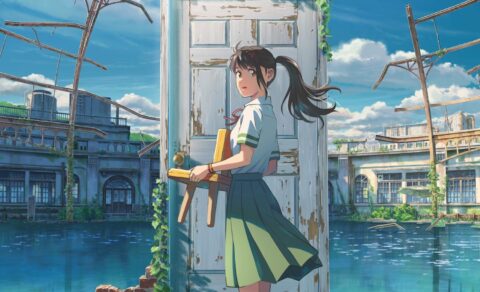Suzume (2022) concerns two overlapping worlds: the real one and the ever-after. There are both ancient gods lingering below the surface and people on earth tasked with keeping them out. There are also two contrasting animation styles — the everyday, observational 2D animation you might find in a Studio Ghibli film or YouTube lo-fi playlist cover art with advanced, cutting-edge computer wizardry pushing the boundaries of modern anime.
Simply put, this is a Makoto Shinkai film.
It may follow a classic anime plot (uniformed, constantly yelling schoolgirl on her bike falls in love with a slightly older man before realising she may have magic powers), but its deep love of Japanese folklore, smart blending of styles and keenly rendered, observational moments give it an elevated, monumental feel. Yet while the small details are excellently felt, the bigger picture is lost beneath a muddled storyline and an overload of style.
The eponymous Suzume (Nanoka Hara) is a normal girl heading to school one day when she cycles past the mysterious college student Sōta Munakata (Hokuto Matsumura). Thanks to the busy, on-the-nose score and her blushed reaction, we immediately understand she is immensely drawn to his otherworldly aura.
He is a Closer — tasked with shutting dangerous portals to the other world with the aid of a magic keystone. Located in shuttered zones evidently meant to reference nuclear disaster zones, including an amusement park right out of Chernobyl, Suzume follows the young couple as they try to stop a huge earthquake from destroying the country.
Mixing elements of the road movie with high fantasy and mythology, Suzume’s strange contrast of tones makes for a bumpy, stop-and-start experience.
Of course, a lot of it looks fantastic. Dramatic, bright, multi-hued skylines, heightened with CGI technicolour and artificial lens flares, imbue the film with urgency and flair. Suzume herself is often contrasted against epic backdrops — starry nights, shining bright blue skies, thunderstorms and cloudy weather — giving her journey an epic, mystical weight.
But at times it is just too much. The contrast levels are higher than in my dentist’s office, the yelling is constant and the eternal drama is laid on far too thick. And the threat itself — a sludgy beam of light piercing the atmosphere — is as indistinct as any world-destroying Marvel event. Aesthetically speaking, when everything else has such specifically rendered textures, why not make the threat to humanity more visually distinct?
The film finds much more endearing notes in its simple touches: whether it’s the regional variations in frying udon noodles, the nostalgic 60s music playing on a car ride, or one character’s comical transformation into a piece of furniture. The film’s true heart is contained within this whimsical picturesque, making the generic Final Fantasy conclusion all that more disheartening.
The Studio Ghibli classic Whisper of The Heart (Yoshifumi Kondō, 1995) is directly referenced at one point, but the final impression is more The Cat Returns (Hiroyuki Morita, 2002). There’s simply too much happening but not enough going on.
Redmond is the editor-in-chief of Journey Into Cinema.
